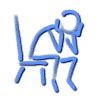Diagnostic criteria for 300.23 Social Phobia
A. A marked and persistent fear of one or more social or performance situations in which the person is exposed to unfamiliar people or to possible scrutiny by others. The individual fears that he or she will act in a way (or show anxiety symptoms) that will be humiliating or embarrassing. Note: In children, there must be evidence of the capacity for age-appropriate social relationships with familiar people and the anxiety must occur in peer settings, not just in interactions with adults.
B. Exposure to the feared social situation almost invariably provokes anxiety, which may take the form of a situationally bound or situationally predisposed Panic Attack. Note: In children, the anxiety may be expressed by crying, tantrums, freezing, or shrinking from social situations with unfamiliar people.
C. The person recognizes that the fear is excessive or unreasonable. Note: In children, this feature may be absent.
D. The feared social or performance situations are avoided or else are endured with intense anxiety or distress.
E. The avoidance, anxious anticipation, or distress in the feared social or performance situation(s) interferes significantly with the person's normal routine, occupational (academic) functioning, or social activities or relationships, or there is marked distress about having the phobia.
F. In individuals under age 18 years, the duration is at least 6 months.
G. The fear or avoidance is not due to the direct physiological effects of a substance (e.g., a druge of abuse, a medication) or a general medical condition and is not better accounted for by another mental disorder (e.g., Panic Disorder With or Without Agoraphobia, Separation Anxiety Disorder, Body Dysmorphic Disorder, a Pervasive Developmental Disorder, or Schizoid Personality Disorder).
H. If a general medical condition or another mental disorder is present, the fear in Criterion A is unrelated to it, e.g., the fear is not of Stuttering, trembling in Parkinson's disease, or exhibiting abnormal eating behavior in Anorexia Nervosa or Bulimia Nervosa. (p. 416-7)




